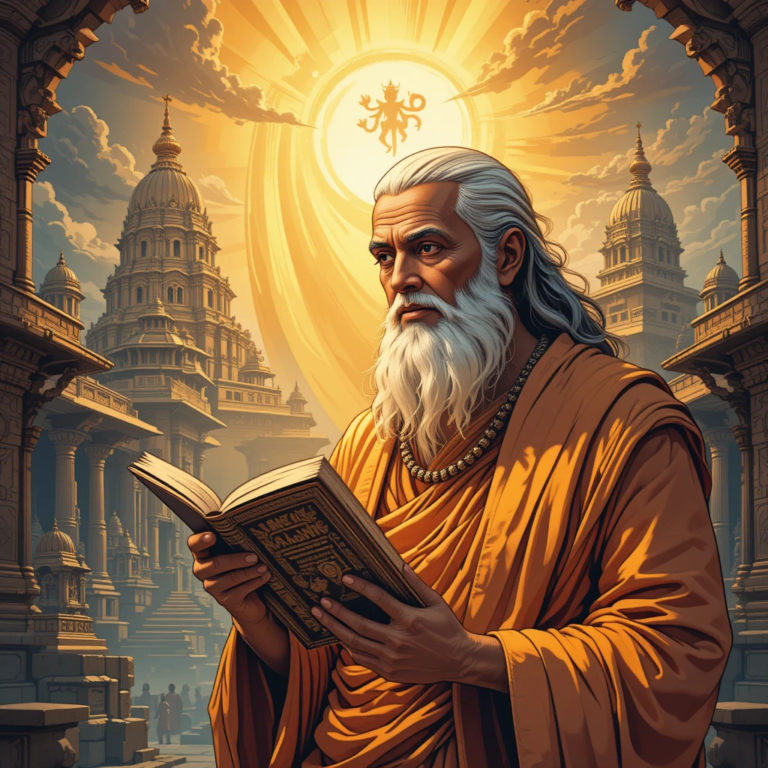Introduction
Ramanuja (c. 1017–1137 CE), one of the most influential philosophers and theologians in Indian history, is celebrated as the founder of Vishishtadvaita Vedanta, a cornerstone of Sri Vaishnava tradition within Hinduism. His philosophy, emphasizing devotion (bhakti) to a personal God (Vishnu), profoundly shaped Hindu theology and practice, particularly in South India. The accounts of his life, particularly his death, and his philosophical teachings are deeply revered, yet they raise questions about their historical accuracy and intent. This article critically examines Ramanuja’s death and the Vishishtadvaita philosophy to determine whether they constitute myths designed to “fool” people, as posed by the inquiry. Through a scientific, critical, and logical lens, supported by textual references, inscriptions, and scientific research where applicable, we explore the historical, philosophical, and cultural dimensions of Ramanuja’s legacy.

Table of Contents
1. Historical Context and Life of Ramanuja
Ramanuja was born around 1017 CE in Sriperumbudur, Tamil Nadu, into a Tamil Brahmin family. Traditional accounts describe him as a precocious child with theological acumen, sent to Kanchipuram to study under Yadavaprakasha, an Advaita Vedanta scholar. Disillusioned with Advaita’s impersonal monism, Ramanuja developed his own philosophy, Vishishtadvaita (qualified non-dualism), which emphasized devotion to Vishnu. He settled in Srirangam, where he reorganized the Sri Ranganathaswamy Temple, established centers for his teachings, and appointed 74 disciples to propagate Sri Vaishnavism. His key works include Sri Bhashya (commentary on the Brahma Sutras), Vedartha-Sangraha (summary of Vedic meaning), Bhagavad Gita Bhashya, and devotional texts like the Gadya Trayam.

Ramanuja’s life is primarily documented through Sri Vaishnava hagiographies, such as the Guru Parampara texts, written by his followers. These sources, while rich in detail, are devotional in nature, often blending historical events with miraculous accounts to elevate his status. For example, stories of Ramanuja’s debates with Jains and Buddhists, leading to their conversion to Vaishnavism, are celebrated but lack corroboration from non-Vaishnava sources. His reforms, including opening temple access to lower castes, reflect a progressive social outlook, though some scholars question the extent of his egalitarianism given the era’s rigid caste system.
2. Ramanuja’s Death: Traditional Account and Evidence
2.1 Traditional Narrative
According to Sri Vaishnava tradition, Ramanuja died in 1137 CE at the age of 120 in Srirangam. The Guru Paramparatexts describe his death as a serene, deliberate act. Aware of his impending departure, Ramanuja announced his intent to his disciples, who pleaded for him to stay. He agreed to remain for three additional days, during which he sanctified a statue to embody his spiritual essence. With his head on the lap of his disciple Embar and feet on Vaduga Nambi, he passed away while listening to the Divya Prabandham (Tamil Vaishnava hymns) and meditating on his guru Yamunacharya’s sandals.

A remarkable claim is that Ramanuja’s body was naturally mummified without chemical preservatives and is preserved in a seated position at the Sri Ranganathaswamy Temple. Unlike typical Hindu cremation practices, his body is said to remain intact, with visible features like eyes and nails, and is cleaned biannually with herbs. Tradition attributes this preservation to divine intervention, with Lord Ranganatha instructing in a dream to keep Ramanuja’s body within the temple.
2.2 Inscriptions and Archaeological Evidence
Inscriptions from the Sri Ranganathaswamy Temple provide some historical context for Ramanuja’s activities but are limited regarding his death. Chola-period inscriptions (11th–12th centuries) confirm the temple’s prominence and Ramanuja’s role in its administration. For instance, inscriptions from the reign of Kulottunga I (r. 1070–1122 CE) mention temple reforms and Vaishnava activities, aligning with Ramanuja’s organizational efforts. However, no specific inscriptions directly reference his death or the preservation of his body. The South Indian Inscriptions (Volume 24, Archaeological Survey of India) document grants and temple activities during Ramanuja’s time but lack details about his passing or mummification.

The preserved body itself could be considered archaeological evidence, but no scientific studies (e.g., forensic analysis or radiocarbon dating) have been conducted to verify its authenticity or preservation method. The lack of such studies is notable, given the extraordinary claim of natural mummification in a humid climate like Srirangam’s.
2.3 Scientific Analysis
- Longevity (120 Years): A lifespan of 120 years in the 12th century is highly improbable. Medieval India’s life expectancy was approximately 30–50 years due to limited medical care, poor sanitation, and nutritional challenges. While exceptional cases of longevity exist, claims of Ramanuja living to 120 are unsupported by independent records and likely reflect hagiographic exaggeration to signify spiritual greatness, a common motif in religious biographies (e.g., similar claims for Adi Shankara or Buddha). Modern gerontological research indicates that even today, with advanced healthcare, reaching 120 is rare, with only a few verified cases globally.
- Natural Mummification: The claim of natural mummification without preservatives is scientifically dubious. Mummification typically requires specific conditions, such as extreme dryness (as in Egyptian mummies) or chemical embalming (e.g., Lenin’s body). Srirangam’s tropical climate, with high humidity, is unconducive to natural preservation without decay. Studies on mummification (e.g., Aufderheide, The Scientific Study of Mummies, 2003) suggest that spontaneous mummification occurs in arid or frozen environments, not humid ones. The biannual herbal cleaning implies some maintenance, possibly involving natural preservatives like camphor or sandalwood, but no chemical analysis of the body exists to confirm this. The absence of cremation, standard in Hindu practice, suggests a deliberate act to elevate Ramanuja’s sanctity, possibly through post-mortem treatment not fully documented.
- Verification Challenges: The body’s preservation is a closely guarded temple tradition, limiting access for scientific study. Without forensic analysis (e.g., CT scans, tissue sampling), claims of natural mummification remain speculative. The “body” could be a statue, a heavily treated corpse, or a relic misidentified as naturally preserved. Comparative cases, like Buddhist mummies in Japan (sokushinbutsu), involve deliberate self-mummification through extreme ascetic practices, which Ramanuja’s biography does not describe.
2.4 Critical and Logical Perspective
- Source Reliability: The narrative relies on Sri Vaishnava hagiographies, written decades or centuries after Ramanuja’s death. These texts, such as the Divya Suri Charita, prioritize spiritual edification over historical accuracy, a common feature of religious biographies across traditions (e.g., Christian saints’ lives). No contemporary non-Vaishnava sources (e.g., Jain or Buddhist records) corroborate the details of his death or mummification.
- Purpose of the Narrative: The story of Ramanuja’s serene death and preserved body serves a theological purpose: it portrays him as a divine figure whose physical form remains a conduit for blessings. This aligns with Sri Vaishnavism’s emphasis on divine grace and devotion, encouraging pilgrimage and veneration. The preserved body, if real, would reinforce community identity and Ramanuja’s enduring presence, similar to Christian relics or Buddhist stupas. This suggests a narrative crafted to inspire faith, not necessarily to deceive.
- Logical Plausibility: The claim of a 120-year lifespan and natural mummification strains credulity without independent evidence. The divine instruction via a dream to preserve the body is a non-falsifiable claim, typical of religious narratives but unverifiable by logic or science. The preservation could be explained by undocumented post-mortem treatments or environmental controls within the temple, but the lack of transparency hinders verification.
2.5 Was It a Myth to Fool People?
The account of Ramanuja’s death appears to be a mythologized narrative, not a deliberate attempt to mislead. In the 12th-century context, hagiographies often included miraculous elements to elevate saints’ status and inspire devotion. The preserved body, if authentic, would have served as a tangible symbol of Ramanuja’s spiritual legacy, fostering community cohesion and pilgrimage. While the claims lack scientific substantiation, they align with the cultural and religious practices of the time, not an intent to “fool” followers. Modern critical analysis would classify the narrative as a hagiographic legend, prioritizing faith over factual accuracy.
3. Vishishtadvaita Vedanta: Ramanuja’s Philosophical System
3.1 Core Tenets
Vishishtadvaita (qualified non-dualism) is a Vedantic philosophy that reconciles the unity of Brahman with the plurality of the world and individual souls. Its key principles are:
- Brahman as Personal God: Brahman is Vishnu, a personal deity with attributes (saguna Brahman) like omniscience, omnipotence, and infinite love, unlike Shankara’s attributeless (nirguna) Brahman. Brahman is the efficient and material cause of the universe, encompassing all reality.
- Reality of Souls and Matter: Individual souls (jivas) and matter (prakriti) are eternal and real, not illusory as in Advaita. They are dependent on Brahman, forming its “body” in a soul-body analogy, where Brahman is the indweller and controller.
- Path to Liberation: Moksha (liberation from samsara) is achieved through bhakti (devotion) and prapatti (complete surrender) to Vishnu. Karma yoga (selfless action) supports bhakti, while jnana yoga (knowledge) is secondary due to its inaccessibility for most. Moksha involves eternal service to Vishnu in Vaikuntha, retaining individual identity.
- Epistemology: Ramanuja accepts three sources of knowledge: pratyaksha (perception), anumana (inference), and shabda (scriptural testimony). The Vedas, Upanishads, Brahma Sutras, and Bhagavad Gita are authoritative, interpreted to support theistic monism.
- Critique of Advaita: Ramanuja refuted Shankara’s Advaita, arguing that an attributeless Brahman cannot account for the world’s diversity. He interpreted “neti neti” (not this, not this) in the Upanishads as negating mundane attributes, not all attributes, thus supporting a saguna Brahman.
3.2 Key Texts
Ramanuja’s philosophy is articulated in:
- Sri Bhashya: A commentary on the Brahma Sutras, countering Advaita’s monism and establishing Vishishtadvaita’s theistic framework.
- Vedartha-Sangraha: A summary of Vedic teachings, reconciling diverse scriptures to support qualified non-dualism.
- Bhagavad Gita Bhashya: An interpretation of the Gita emphasizing bhakti and divine grace.
- Gadya Trayam: Devotional prose (Sharanagati Gadyam, Sriranga Gadyam, Vaikuntha Gadyam) outlining surrender to Vishnu.
3.3 Intellectual Rigor
Ramanuja’s philosophy is philosophically rigorous, engaging with rival schools like Advaita, Dvaita, and Nyaya. His arguments are grounded in textual exegesis, logical reasoning, and theistic interpretations of the Prasthanatrayi(Upanishads, Brahma Sutras, Bhagavad Gita). For example, his critique of Advaita’s maya (illusion) theory posits that an illusory world contradicts the Upanishads’ affirmation of reality. His soul-body analogy provides a coherent model for unity-in-diversity, avoiding the extremes of absolute monism (Advaita) and absolute dualism (Dvaita).
4. Scientific and Critical Analysis of Vishishtadvaita
4.1 Scientific Perspective
- Metaphysical Claims: Vishishtadvaita’s core assertions (e.g., eternal souls, personal God, moksha) are metaphysical and beyond empirical testing. Science, which relies on observable, falsifiable data, cannot validate or refute these claims. For instance, the concept of Brahman as Vishnu is a theological proposition, not a hypothesis testable by experiment.
- Psychological and Social Effects: Bhakti-based practices have measurable psychological benefits, such as reduced stress and increased community cohesion, as seen in studies on religious practices (e.g., Koenig, Handbook of Religion and Health, 2012). These effects suggest practical utility but do not confirm metaphysical truth.
- Scriptural Reliance: Ramanuja’s dependence on Vedic texts as authoritative knowledge contrasts with scientific epistemology, which prioritizes empirical evidence. While his use of inference (anumana) aligns with logical reasoning, its conclusions (e.g., Vishnu’s existence) lack empirical grounding.
4.2 Critical and Logical Perspective
- Internal Consistency: Vishishtadvaita is logically consistent within its theistic framework. The soul-body analogy elegantly reconciles unity and plurality, and Ramanuja’s scriptural interpretations are systematic. His refutation of Advaita’s nirguna Brahman is grounded in textual analysis, arguing that negation implies divine attributes, not their absence.
- Comparison with Rivals: Ramanuja’s philosophy engages robustly with Advaita and Dvaita. Against Shankara, he argues that an illusory world undermines the Vedas’ authority. Against Madhva’s Dvaita, he asserts that souls share Brahman’s essence, avoiding absolute dualism. These debates demonstrate intellectual sincerity, not deception.
- Cultural Context: Vishishtadvaita emerged in a period of philosophical pluralism and growing bhakti movements. By making spirituality accessible through devotion, Ramanuja addressed the needs of diverse social groups, challenging Advaita’s elitism. This pragmatic approach suggests a genuine intent to guide, not mislead.
- Potential for Manipulation: Theistic philosophies like Vishishtadvaita, with their emphasis on surrender, could be exploited to enforce compliance. However, Ramanuja’s focus on ethical living (dharma) and inclusivity (e.g., temple access for lower castes) indicates a system designed to uplift, not deceive. The philosophy’s accessibility contrasts with Advaita’s abstract complexity, suggesting an intent to empower rather than manipulate.
4.3 Was It a Myth to Fool People?
Vishishtadvaita is not a myth in the sense of a fabricated falsehood but a philosophical system rooted in scriptural interpretation and logical argumentation. Its metaphysical claims are untestable by science, but they were not intended to be scientific. Ramanuja’s engagement with rival philosophies and his emphasis on devotion reflect intellectual and spiritual sincerity, not an intent to deceive. The philosophy’s enduring influence in Sri Vaishnavism and its role in the bhakti movement demonstrate its cultural significance, not a scheme to “fool” followers. Critics might argue that its reliance on divine authority encourages uncritical faith, but this is a feature of theistic traditions, not evidence of malicious intent.
5. Cultural and Social Impact
Ramanuja’s teachings had a profound impact on Indian religion and society:
- Bhakti Movement: Vishishtadvaita provided a philosophical basis for the bhakti movement, influencing saints like Chaitanya and Vallabhacharya. Its emphasis on devotion democratized spirituality, making it accessible across castes.
- Temple Reforms: Ramanuja’s reorganization of the Srirangam temple and establishment of 74 teaching centers spread his philosophy, fostering Vaishnava communities. Inscriptions from Srirangam confirm his administrative role, though they do not detail his death.
- Social Inclusivity: Ramanuja’s inclusion of lower castes in temple worship challenged social norms, though its extent is debated. His philosophy’s focus on universal access to salvation through bhakti promoted social cohesion, aligning with his ethical teachings.
- Legacy: The preservation of Ramanuja’s body (if authentic) and the Statue of Equality in Hyderabad (inaugurated 2022) reflect his enduring legacy. These symbols reinforce Sri Vaishnavism’s identity and attract devotees, underscoring the narrative’s cultural role rather than deceptive intent.
6. Conclusion
The accounts of Ramanuja’s death and Vishishtadvaita Vedanta reflect the conventions of 12th-century religious tradition, blending historical elements with hagiographic embellishments. The claim of a 120-year lifespan and natural mummification lacks scientific evidence and is likely mythologized to enhance Ramanuja’s divine status. However, these narratives align with the cultural practice of venerating saints, not a deliberate attempt to “fool” people. Vishishtadvaita is a philosophically rigorous system, grounded in textual analysis and logical reasoning, designed to guide spiritual and ethical life, not to deceive. Its metaphysical claims are untestable by science, but its psychological and social benefits are evident.
The absence of contemporary inscriptions or scientific studies on Ramanuja’s body limits verification of his death narrative. His philosophy, however, engages robustly with rival schools, demonstrating intellectual integrity. Both the death account and Vishishtadvaita served to inspire devotion and community cohesion, fitting the religious context of medieval India. While modern critical analysis may question their factual basis, there is no evidence of intent to mislead. Instead, Ramanuja’s legacy reflects a sincere effort to synthesize philosophy and devotion, leaving a lasting impact on Hinduism.
References
-: Ramanuja – Wikipedia. Published: 2022-02-08.
-: Ramanuja | Hindu Theology, Philosophy & Advaita Vedanta | Britannica. Published: 2025-04-11.
-: Ramanujacharya – Statue of Equality, Philosophy, Contributions – vajiramandravi.com. Published: 2025-01-28.
-: Vishishtadvaita – Wikipedia. Published: 2004-10-13.
-: Vedanta – Wikipedia. Published: 2024-12-07.
-: Ramanuja’s Philosophy of Divinity: From Brahman to Narayana – ResearchGate. Published: 2019-10-08.
- Aufderheide, A. C. (2003). The Scientific Study of Mummies. Cambridge University Press.
- Koenig, H. G. (2012). Handbook of Religion and Health. Oxford University Press.
- South Indian Inscriptions, Volume 24. Archaeological Survey of India.




